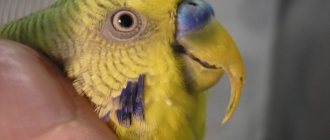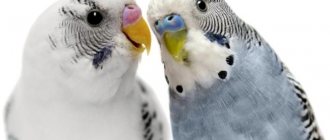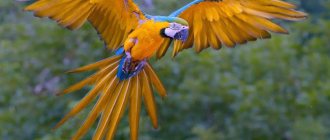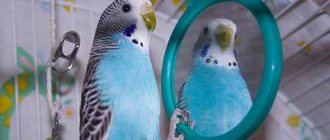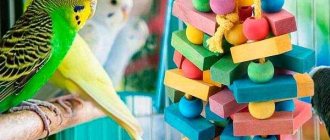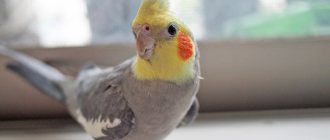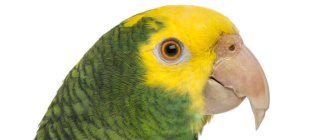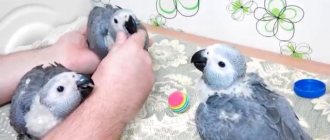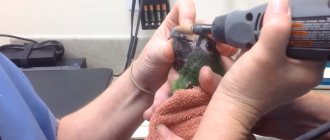Beak
- a characteristic anatomical feature of birds. It is designed to perform a variety of functions. This is food and water intake, an additional point of support when climbing, a weapon of defense, a skin and feather care product, a communication tool, etc. The beak of birds consists of a jaw bone covered with a light shell of keratin (similar to the keratin of nails and hair of mammals and humans). Conventionally, the beak can be divided into 2 parts: living tissue - jaw bones, muscles, growth zone of the horny sheath and dead, keratinized tissue - the horny sheath itself. The beak constantly grows and wears down due to friction against rough surfaces (when eating, moving along branches and perches), as well as against itself (the friction of the upper beak on the lower beak). The part of the beak closest to the head - the growth zone - has a blood supply and a large number of nerve endings, but the tip of the beak is insensitive. Parrots are characterized by mobility of the upper jaw and developed muscles of the jaws, which turns the beak into a powerful tool (like a wire cutter) that develops great force when compressed.
A "normal" cockatoo beak.
Pathological curvature of a parrot's beak is a common reason for visiting veterinary clinics.
Deformation of a parrot's beak
It can be congenital and acquired. The halves of the beak may not close together or, conversely, grow excessively. The chick is usually fed for the first week, then the bird learns to eat on its own. Acquired deformity can appear after a fall or blow, with a fracture of the beak or displacement of the jaw bones.
In this case, you need to quickly show your pet to the veterinarian, since in addition to external damage there may also be deep hemorrhages and growths. If nothing is done, the bird may die of starvation.
Beak structure
The beak of a budgerigar consists of the following sections:
- the beak, formed by the jaw, premaxillary and nasal bones;
- the mandible formed by several small bones;
- tendon ligament, with the help of which the organ is movably connected to the bones of the skull;
- cere with nasal openings.
The outside of the organ is covered with a layer of horny substance. A healthy beak has a smooth, hard, shiny surface. A slight layering at the edges is acceptable, due to the fact that the horny substance is constantly renewed, grows and wears off. However, severe delamination, the appearance of cracks and growths are signs of the disease.
A parrot has a long beak: what to do?
Sometimes the beak flaps grow too quickly: they curl, cling to each other and cause a lot of discomfort to the bird. The overgrown stratum corneum will continue to grow, so the beak needs to be trimmed. There are several reasons for this phenomenon: metabolic disorders, feeding exclusively with soft food, previous beak trimming. It is better to entrust the “haircut” to a specialist, since the beak of the wavy is riddled with nerve fibers and blood vessels - you can accidentally injure it. After the operation, the bird is given only soft food for 2-3 days.
Causes of damage
Structural disorders in the organ area interfere with normal nutrition and plumage care. Severe injuries are a serious threat to the bird's life. The reasons for the loss of beak integrity in parrots can be:
- attempts to chew food that is too hard;
- violation of the stratum corneum;
- conflicts with other birds in the cage;
- infections and parasitic lesions;
- mechanical injuries, fractures, cracks.
Damage in the form of chips or tears often occurs when a parrot hits a hard surface at high flight speed. The fragility of the beak also increases with the porosity of the stratum corneum as a result of poor nutrition and disease.
The beak of birds constantly grows and wears out, thus, regular renewal occurs. Scratches and peeling disappear over time. Infectious lesions (viral, fungal, or bacterial etiology) can lead to the destruction of the stratum corneum, making the organ more vulnerable.
Adequate treatment of diseases and a balanced diet are important conditions for the health of a pet. The organ can break down if there is a lack of calcium and vitamins in the bird’s body. The surface becomes brittle, flakes and peels.
Parasitic lesions also affect the structure of the horny tissue. It is necessary to take emergency measures to eliminate the problem, cure the bird and disinfect the cage.
Growth on the beak: what to do?
Often the causes of growths on the beak are parasitic mites. In shape and structure they resemble either pumice or a coral reef. Also, formations can be in the eye area, on the cloaca and paws of a budgerigar. If the parrot is not alone, it is better to remove the neighbors. The cage is disinfected with Ecocide, Virocide, Neostomozan or a solution of potassium permanganate, and then thoroughly rinse the compositions with hot water. Feed, sawdust, mineral stones need to be replaced. If there are wooden perches in the cage, they need to be disinfected and removed for a while. The affected areas on the beak are treated with avesectin ointment once every two days, vitamins and mineral supplements are added to the diet - a veterinarian can recommend them.
Treating wounds in birds, stopping bleeding, treating paws.
Wounds in birds are best treated with liquid betadine (alcohol-free iodine) or miramistine (chlorhexidine). (For those living abroad: The Latin names of betadine are betadine; povidone iodide. The Latin name of chlorhexidine is chlorhexidinum. Synonyms and trademarks: Gibitan, Hexicon, Sebidin, Hibitan, Abacil, Biotensid, Chlorohex, Corsodyl, Fimeil, Hexadol, Hexol, Hibitane, Nolvasan, Plivasept, Rotersept, Sebidin, Septalone, Soretol, Sterilone, etc.) Among the healing ointments, you can apply Levomekol ointment.
All these products can be purchased at a human pharmacy.
If you don’t have them on hand, you can at least treat them with hydrogen peroxide before purchasing them.
DO NOT smear the wound with regular iodine: it causes a mild burn, not only destroys microorganisms, but also slows down the healing of damaged tissue. If the wound is quite deep, other medications may be needed. In this case, first treat the wound with betadine or miramistin, and then apply levomekol, levasin or iruksol ointment directly into the wound.
If the bird is injured by a cat, be sure to treat the bird:
fluoroquinolones are usually used (enrofloxacin (Baytril, Enroflon), ciprofloxacin, ofloxacin, norfloxacin, etc.), at a dosage of 20-40 mg/kg/day, for large birds - at the bottom of the dosage, for small birds - at the top (do not confuse , small ones have a faster metabolism, and the dose is needed higher!) or penicillins - ampicillin, amosicillin, ampiox, amoxiclav at a dosage of 125-175 mg/kg/day, the principle is the same for small/large ones. Combined ones are considered penicillin. These antibiotics are convenient because they have a wide spectrum of activity, and at the same time they suppress other causative agents of wound infections - staphylococci, streptococci, etc. The course, in the absence of inflammation at the wound site, is 7 days.
If the wound is contaminated, then no matter how it was received, you need to treat the bird with the recommended antibiotic, as in the case of a wound received from a cat. You need to wash off all the dirt and pus from the wound, and then treat it as described above.
STOP THE BLOOD: Dicinone ampoule on a napkin, and wrap it around your claw and finger, hold until a clot forms.
TREATMENT OF PAWS.
The most common cause of sores on the feet of the feet is unsuitable perches, plastic (too hard for the bird's feet) or thin (the load on the foot is unevenly distributed on them). The perches should be wooden and thick enough for the bird to grasp 2/3 of them. The branches of which trees and shrubs can be offered to the bird as perches and twigs for gnawing.
Wrap the perches tightly with cotton or linen twine, or, in extreme cases, with a new, clean cord, and soak them in Levomekol ointment. (It is best to use Levomekol ointment: it not only disinfects, but also promotes healing.) The bird’s paws will be in contact with the medicine all the time. And the wrapping will make the perches soft, and it will not be so painful for the bird to sit on them while the leg heals. Levomekol can be purchased at a human pharmacy.
Sometimes wounds on the feet of the feet appear due to a lack of vitamins, especially vitamin A. Recommended vitamin complexes for birds are Vita-Sol, Multi-Drops, Beafar Vinka, Mauser-Tropfen, Orlux Muta-Vit, Orlux Omni-Vit. Some of them contain not only vitamins, but also amino acids (components of proteins), so they spoil at room temperature and must be stored in the refrigerator. When added daily to food or drinking water, the duration of the course of the vitamin complex is 2 weeks. The duration of the break between courses is 2 months. In what cases should vitamin complexes not be given? 1. If the liver is unwell. (Symptoms: - the beak outgrows, sometimes along with the claws. - the beak does not outgrow, but dark spots appear on it. - the droppings are yellow, bright green or whitish. - vomiting, combined with the outgrowing of the beak, or a change in the color of the droppings to yellow, bright -green or whitish. If vomiting is combined with reddish droppings, this is not a sign of liver malaise, but the presence of parasites.) Synthetic vitamins are a problem, it creates a load on the weakened liver. Therefore, if the liver is unwell, they should not be given.
2. If you have stomach problems, pancreatitis or diabetes. (Symptoms of pancreatitis: light-colored droppings, similar in shape to puffed rice. Sometimes with pancteatitis, droppings do not change color, but undigested grain appears in it. But most often, undigested grain in droppings appears due to dysbacteriosis, a lack of beneficial microorganisms that promote digestion. Therefore, when undigested grain appears in the droppings, you need to give a PRObiotic containing beneficial microorganisms. If, after a course of PRObiotics, grain stops appearing in the droppings, it means that the cause was dysbiosis, not pancreatitis. Symptom of diabetes: the amount of water you drink increases significantly, despite the fact that the water is spring or settled, and not boiled.) Synthetic vitamins should not be given, again because they, of course, create a load on the pancreas.
3. For lipoma, wen, benign tumor, on the chest or abdomen. Also for a malignant tumor. (Lipoma, wen is usually yellow in color.) The vitamin complex should not be given because it can cause the tumor to increase. It is necessary to give natural sources of vitamins, fruits, vegetables and green food, recommended in the article “Feeding parrots” and in the subsection of the forum “Vegetables, fruits, berries, greens”.
4. When treated with immunostimulants or immunomodulators, regardless of the diagnosis for which they are prescribed.
In these cases, you can only give natural sources of vitamins, fruits and vegetables. Natural sources richest in vitamin A: carrots, red peppers, zucchini, spinach.
If levomekol and a course of vitamins do not help, it means that the inflammation does not go away due to infection, and the infection has penetrated quite deeply into the wound. In this case, you have to give another medicine. But first, you need to have a scraping or discharge from the wound analyzed in order to determine the type of microorganism and select the medicine to which it is most sensitive.
List of trees and shrubs whose branches can be offered to the bird as perches and twigs for gnawing:
apple tree cherry raspberry birch linden maple willow (willow, willow) alder rowan hawthorn elderberry ash elm currants (provided that the bushes are not treated with chemicals) viburnum
You MUST NOT give branches to the following trees:
oak pear (like oak, contains tannins) conifers (birds can get dirty in resin) bird cherry (contains a large amount of tannins) poplar (bark and wood accumulate harmful substances from the atmosphere to a greater extent than the bark and wood of other trees)
It is imperative to take live twigs (microfungi settle on the dead ones, destroying wood and being very harmful to birds).
The parrot's beak is peeling: what to do?
Basically, the beak softens and peels off due to an unbalanced diet. Bacterial and fungal diseases can also be the cause, so it is better to show the bird to an ornithologist - he will make a final diagnosis. As for prevention, the pet’s diet should be complete - grain mixtures, herbs, fruits, berries, vegetables, mineral supplements. The cage definitely needs branches of fruit trees, grass, and a mineral stone for grinding down the beak. You cannot prescribe vitamin preparations and immunomodulators on your own; hypervitaminosis is no better than a lack of vitamins.
Help
Beak treatment must be carried out immediately after identifying the problem and making a diagnosis, since the inability to eat or breathe normally leads to the rapid development of other diseases, and in advanced cases, to death. The bird should not be treated on its own; You should first consult your veterinarian.
Treatment procedures depend on the final diagnosis. For parasitic, fungal and bacterial infections, appropriate medications are prescribed. If a parrot's beak is broken, it is fixed with special glue and wire. If a bird's beak has darkened, this indicates tissue necrosis; in this case, it is impossible to restore the function of the organ. If the beak looks flaky or soft, or growths have appeared on it, it is necessary to adjust the parrot's diet and introduce vitamin and mineral supplements into it. If the bird's beak shape has changed, it is trimmed accordingly; The same is done for congenital deformities and excessive growth. This must be done carefully so as not to damage the blood vessels.
For any lesions on the beak, the bird requires a special diet. If eating causes pain in your parrot, it should be fed mainly soft and liquid food. Sometimes force feeding through a syringe or tube may be necessary.
Inflammation of the eyelid and conjunctivitis of the eyes
It is often a consequence of careless keeping of budgies, sometimes due to the presence of harmful gases such as ammonia or hydrogen sulfide in the air; the harm of tobacco smoke has also not been canceled.
At the initial stage, the conjunctiva swells, acquiring a reddish tint. The eyelids may be closed and look swollen. Fluid is released, which ultimately, as the disease progresses, leads to partial or complete gluing of the eye in parrots.
Conjunctivitis is often associated with drafts and hypothermia, so try to become especially vigilant about the health of your little pets in the winter and autumn. With fever, conjunctivitis can be a concomitant disease, being an additional symptom.
Corella plucks feathers from a male
From: Daria Tel.: 89772
Message: FEMALE CORELLA Plucks FEATHERS ON THE MALE'S HEAD. THEY LIVE TOGETHER FOR 3 YEARS. LOVE EACH OTHER VERY MUCH
Good afternoon Of course, you need to look at the parrot to say anything definite, but even now, based on your data, we can suggest the drug trichoptyline for treatment (you can order it at the address) and the drug vetom on the tip of a knife in the drinking bowl along with trichoptyline. Also, the diet of parrots needs all the necessary microelements - in a word, add shell rock! All medications are given for 1 to 2 months without interruption.
Sincerely, Vladimir Romanov
How can I prevent future beak fracture injuries?
When it comes to natural causes such as infections, cancer and birth defects, there is not much you can do, but for other causes there is a lot you can do to prevent your parrot from breaking its beak.
Parrot-proof your home for safe indoor flight
If you are going to let your parrot fly around your house, make sure your home is safe first. For example, be sure to cover all open flames and pots with hot substances, and close open doors that could unintentionally hit your parrot while moving.
Trim your bird's wings
One of the most common ways to prevent beak breakage is to trim your parrot's wings.
However, this should be done by a professional who can trim enough feathers to prevent flight, but not so many that the parrot falls over when it tries to fly.
The best way to prevent beak breakage and injury is to have your parrot checked regularly by a veterinarian so that any abnormalities can be noticed before they develop and become difficult to treat.
Common diseases
Next, briefly about common ailments of parrots, why do they occur?
Doesn't fly
A parrot is a very active bird in itself and, naturally, a person will certainly be upset by the fact that his pet has stopped flying. There may be several reasons why the parrot sits at the bottom of the cage and does not fly, and sometimes just sleeps.
- Wrong diet. The bird does not receive all the vitamins, which is why it is apathetic, lethargic, inactive and no longer has the time to fly.
- Excess weight and atrophy of the wing muscles. If you rarely let your parrot fly, and his cage is small and uncomfortable, his muscles may atrophy and become obese.
- Trauma and stress.
- Parasitic diseases and infections.
Dark spot on beak
A dark spot on a parrot's beak is in most cases a symptom of mechanical damage. Perhaps the bird did not fit into the cage door, perhaps it damaged its beak on a perch, or had an argument with a neighbor. On your part, constant monitoring of the stain is required for several days. If it grows and darkens, it may be a fungal infection. In this case, specialist consultation and the use of external antifungal drugs are required.
Polyuria
Polyuria is a disease characterized by increased urine production. Polyuria is often a symptom of many infectious diseases. Normally, in birds, urine from the urethra enters the cloaca, where it combines with feces and is excreted from the body. With polyuria, this process is disrupted and its external manifestations resemble diarrhea. If your feathered pet has polyuria, there may be several reasons for this:
- stress and poor diet (often cause polyuria);
- infectious diseases (may be accompanied by polyuria, the parrot sleeps, refuses to eat);
- diseases of the urinary system - nephritis and cystitis (polyuria is one of the leading signs);
- Polyuria can also occur in parrots during the laying period.
Paw fracture
If your parrot is not kept in the right conditions and is hyperactive, it may well damage, break, dislocate or bruise a leg or even a wing. If you notice that the bird cannot stand on any of its limbs or its leg is unnaturally turned out, it most likely broke it. A closed fracture will take about 2-3 weeks to heal, while the leg that the bird broke needs to be fixed. Only a doctor can do this correctly, otherwise the bird may die.
Constantly sleeping
If your bird constantly sleeps, hides its head, does not drink or eat, this is a serious symptom and a reason to see a doctor. Indeed, without exaggeration, almost all diseases of parrots are accompanied by the need to sleep, apathy and inactivity. A parrot can sleep and be unkempt if it has a cold, infectious or parasitic disease. Keep in mind that without treatment the bird will soon die.
Choked
There are, of course, cases when a bird actually chokes on food. But if you notice that your parrot is constantly choking, there are several answers to the question of why this is happening:
- Inflammation of the goiter (chokes when eating, needs to be treated promptly, birds die from it).
- Tracheal mites or other parasites (irritate the mucous membrane and the bird choke).
- The parrot seems to “choke” to regurgitate food during courtship.
Sits on one leg
Please note that constantly sitting on one leg, with the other one clenched into a fist, is normal for parrots. However, if it is noticeable that it hurts the bird to step on one of its legs, you need to carefully examine it. Perhaps he damaged it, there are wounds, corns or calluses on it, which arise due to the wrong perch that rubs the skin. Or your pet has broken a leg. Also, soreness of the paws is an important symptom in some diseases of the internal organs.
Psittacosis
Psittacosis is a disease transmitted to humans. The insidiousness of psittacosis is that it can occur with minimal symptoms that look similar to a cold. Most often, psittacosis manifests itself in the fact that the bird becomes lethargic, does not eat, does not drink, hides its head and sleeps a lot. There is trembling, poor appetite, thirst, ruffled feathers and inflammation of the mucous membranes, sometimes the bird lies on its back. Therefore, only a veterinarian can distinguish psittacosis from a common cold.
Treatment of psittacosis must be carried out promptly (otherwise the bird will die), with the use of antibiotics and mandatory isolation of the sick bird. We invite you to watch a video about psittacosis!
Classification of wounds
There are several types of wounds. By origin, they can be bitten, stabbed, cut, crushed, bruised, or surgical.
Often the appearance of wounds is accompanied by bleeding.
Depending on the type of damaged blood vessels, bleeding from a wound is divided into:
- arterial (the artery is damaged) - scarlet blood rich in oxygen flows out of the wound in a strong stream (its height is constantly changing);
- venous (a vein breaks through) - dark blood, saturated with carbon dioxide, flows with less force, but at a constant speed;
- capillary (capillaries are damaged) - blood seeps out in drops from several places and, merging, forms thin streams.
Corella began to freeze. Neurogenic disease of the parrot.
From: Alexander Tel.: (916)807
Message: Hello. Corella parrot, male, age - about 1.5 years.. In mid-September, we were treated at your clinic, diagnosed with acute pancreatitis. At the time of contacting the clinic, severe exhaustion was recorded. Revealed: Staphylococcus gallinarium, Enterobacterium SPP, Enterococcus SPP. After discharge, hilak forte, bacteriophage staphylococcus, lactobifadol, soaked Padovan paroketti + boiled buckwheat were prescribed for home treatment. A month later, after completing the course of treatment, the litter returned to normal, the parrot slowly gained weight to a maximum of 78 grams. Switched to dry food Padovan + boiled buckwheat and rice (alternating every other time), melon seeds (loves). For a month his condition was stable: he was active, talked, but did not fly much. Added pumpkin seeds to the diet (2-3 per day). A week ago we noticed that the parrot began to feel cold (the temperature in the room did not change), and its weight began to decrease. They were transferred to quarantine under heating. He began to eat a lot of sand/stones - he spent more time in the plate with stones than in the feeder. The stones were removed and undigested grain appeared in the droppings. He began to weaken, became restless, constantly asked for food (he sits on his finger, chirps and shakes his wings, as chicks do in a nest when they see their parents with food). Started losing weight. They gave me bacteriophage and lactobifidol. After a telephone consultation with clinic specialists, they switched to a boiled egg with yolk + boiled corn - she eats a lot, has a good appetite, but practically only an egg (she eats half a day without leaving anything). Padovan was temporarily removed - the droppings consisted entirely of undigested grain. Now weighs 74 grams. Today I started twitching both paws (the perch is wooden, 18 mm in diameter, there are no swellings on the soles), the stool is loose.
Question: 1. Are there too many protein foods? 2. Is it possible to give boiled vegetables: carrots, potatoes, cabbage? 3. Is it possible to give boiled rice - his favorite dish? 4. What medications should I give? 5. Is it possible to determine the cause of the twitching of the paws? 6. It is unclear what factors could provoke a relapse of the disease.
Good afternoon I answer in order: 1) If the bird is losing weight, then do not limit protein intake! 2) Of course, there are no contraindications for boiled vegetables, but then there is no point in them either. 3) Yes, boiled porridge can be given, especially during illness. 4) From medicines, you can give temperin, panangin, vitamins B1, B12, C, probiotics. And sarcomin 5) Disorder of the somatic nervous system. Neurogenic symptoms. The etiology can vary from a violation of the innervation of the spinal nerves, to a stroke or heart disease. For an accurate answer, you should undergo an examination at a bird hospital. Sincerely, Vladimir Romanov
Knemidocoptosis
If the beak turns black or grows back, this is not the worst thing that can happen to a parrot. It is much worse if the bird becomes infected with parasites. These microscopic mites of the genus Knemidocoptes infect non-feathered areas of the body: paws, wax, area around the eyes. Pests live in the epidermis and feed on skin flakes. Their movements and waste products cause severe itching. Ticks are not visible during normal examination, but their presence is indicated by the following symptoms:
- the bird itches intensely and pecks its paws;
- growths appear on the wax;
- crusts accumulate around the eyes;
- plaque on the beak.
In the advanced stage of the disease, the mites move to the beak, it peels off, and its structure is destroyed. Due to the abundance of internal channels, it becomes loose and porous. Getting rid of scabies mites is not easy, you need a systematic approach. To begin with, the bird is isolated from other pets. Disinfect the cage and change all equipment. Aversectin ointment or Vaseline oil is applied daily to the skin and keratinized surface. The course of treatment is from two weeks to a month.
